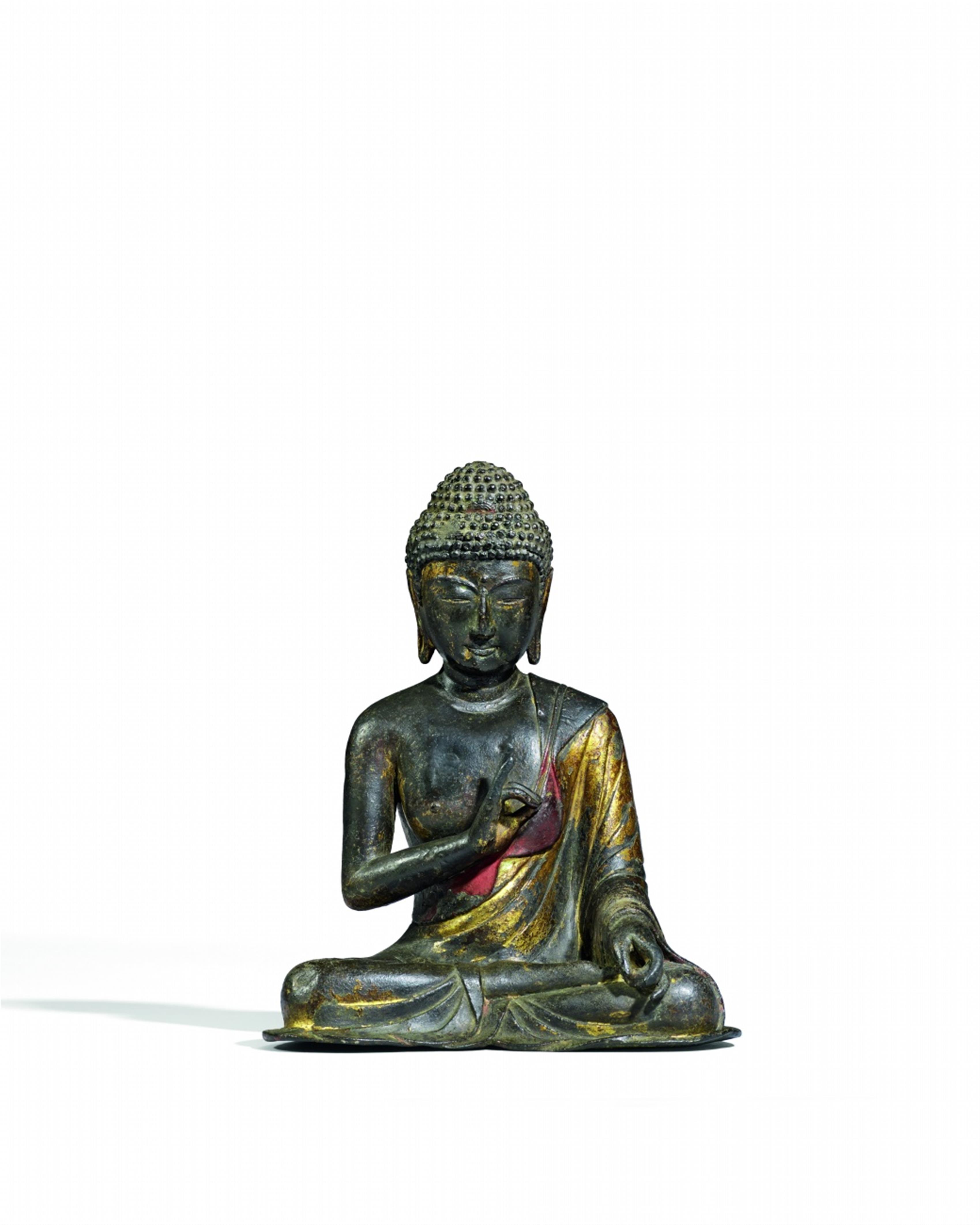A rare Yunnan bronze figure of Buddha Amitabha. Dali kingdom, 12th century
A rare Yunnan bronze figure of Buddha Amitabha seated in meditation, the right hand raised in karana mudra, the left hand in mudra is placed on the knee. Remains of gilded lacquer and red pigments to the garment. Dali kingdom, 12th century. Wooden stand, carved in the shape of a double lotus.
Height 30 cm
The Dali Kingdom centered in the area of today's Yunnan Province between the 7th and 13th centuries. Buddhism in the early 9th century replaced the indigenous shamanistic cult resulting in a religious boom, after Buddhism had lost its predominant position in the Chinese mainland.
According to legend, Bodhisattva Avalokiteschvara personally gave the new kingdom its name. The great veneration which was bestowed on the Bodhisattva Guanyin in the Dali Kingdom was also reflected in the numerous stylistically and iconographically homogeneous sculptures in gilt bronze, such as the Acuoye Guanyin.
Figures of the Buddha seated in the meditation are rare. They are mostly identifiable by name according to the gesture of their hands (mudra). The present Buddha offered for auction holds the right hand in a modification of the dharmachacra mudra, or vitarka mudra, also known as karana mudra, and can be identified as the preaching Buddha (cf. Der Goldschatz der drei Pagoden, exhib. cat. Museum Rietberg Zurich, 1991, p. 161-162). The figure is an example of the iconographic diversity that is reflected for instance in the group of the Five Buddhas of Esoteric Wisdom (wuzhi rulai), the most common in the Dali Kingdom being Buddha Vairocana.
The stylistic features particular to these Buddha figures are the relatively large head in comparison to the gently sloping shoulders, and the voluminous coiffure made up of small curls arranged around an equally large and wide ushnisha. The eyes however, lowered in meditation, consist of narrow, protracted slits. The austere yet graceful facial features are an important characteristic of these rare Buddha figures from Yunnan.
十二世紀 雲南大理國 銅鎏金阿彌陀佛坐像
來源:德國北威州私人收藏,二十世紀二十年代購於中國
可比:克利夫蘭藝術博物館:錄入The Handbook of the Cleveland Museum of Art, 克利夫蘭 1978年,頁225; 上海博物館:錄入孫迪著,中國流失海外佛教造像總合圖目,卷7,北京2005年,頁1375; 威廉斯敦的藝術博物館:錄入 李雪曼(Sherman E. Lee)及何惠鑒(Wai-Kam Ho)著, Chinese Art under the Mongols. The Yuan Dynasty (1279-1368), 克利夫蘭 1998年,編號13
Provenance
Private collection, North Rhine-Westphalia, according to the consignor acquired by a family member in China in the 1920s
Literature
Compare the following bronze figures of Buddha from the Dali kingdom: Buddha Amitabha, Cleveland Museum of Art, illustrated in The Handbook of the Cleveland Museum of Art, Cleveland 1978, p. 225, acc. no. 42-1082; Buddha, Shanghai Museum, with inscription bearing the date 1163, illustrated in: Sun Di (ed.), Zhongguo liushi haiwai fojiao zaoxiang zonghe tumu (A compendium of Chinese Buddhist sculpture in overseas collections), vol. 7 Beijing 2005, p. 1375; and Vairocana Buddha in the Williams College Museum, illustrated in Sherman E. Lee and Wai-Kam Ho, Chinese Art under the Mongols. The Yuan Dynasty (1279-1368), Cleveland Museum of Art, 1998, no. 13

